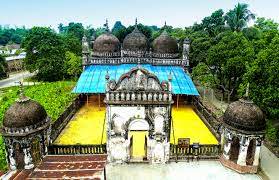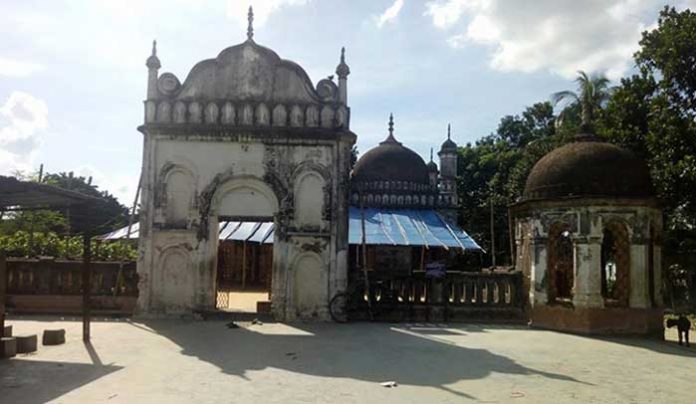Hundred year old Jhaudia Shahi Mosque located at Jhaudia village in Kushtia sadar upazila, about 6.5 km west of the Kushtia-Jhenaidah highway. There are many mysteries surrounding the mosque. However, no one knows the exact history of when and who built it.
The mosque is built on a low plinth with an open courtyard. The main mosque is an oblong building and the entire compound is surrounded by a wall. There are two additional octagonal domed pavilions on the corners of the front boundary wall.
These corner towers are similar to those of Sat Gambuj Mosque in Dhaka and Ghoraghat Fort mosque in Dinajpur. Each pavilion has four axial arched openings. Their presence suggests that they were used as madrassah or for reciting the Quran. In between the pavilions, in the middle of the eastern boundary wall, there is a gateway to enter the mosque premises.
It is known that there is no history or book about the mosque. However, according to many locals, the mosque was miraculously uprooted many years ago. Since then, Muslim mosques have been maintained and worshiped. Since then, word of the construction of the mosque spread in the area and many people came to see it. 
Many claim that Shah Sufi Adari Mia came from Iraq about 1100 years ago to spread Islam in Jhenaidah, Kushtia and Bagerhat. He settled in the village of Jhaudia between Jhenaidah and Kushtia. It is said that he built the mosque and preached the religion in the whole area. After the death of Adari Mia, he was buried in the area adjacent to the mosque. However, the locals said that he had no descendants in that place. A shrine committee was set up to maintain his grave.
There is also more disagreement about the construction of the mosque. The entrance to the mosque is inscribed with a large man-made identity and was established during the reign of the Mughal emperor Aurangzeb.
But there is no mention of who built it at that time. Even local conscious people could not say anything about its origin. The mosque is made of brick, stone, sand and porcelain. It has 5 lovely domes on the top and two minarets at the entrance. It has wonderful artistic craftsmanship. Easily captivating.
It is currently maintained by the government’s Department of Museums and Archeology.


